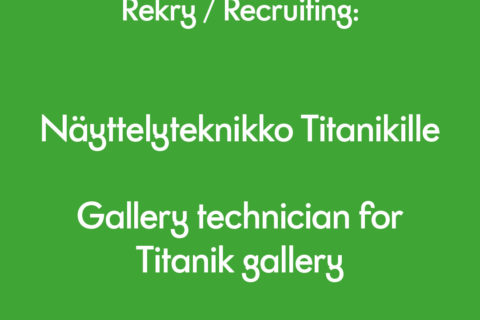Curtis Tamm (s. 1987, USA) luo ympäristöjä joissa tilallistettu ääni ja kuva elävöittävät yhteisöllisten kokemusten aistillista epäjärjestystä, ja leikkisän kosmologian kautta kuvittaa aistinelintemme geologisen syntyperän. Nämä kokemukset murtavat ja uudelleen järjestelevät eläinten ja asioiden evoluutiollisen aikajanan, kaivaen esiin ihmisten, eläinten ja elottomien objektien välisen mahdottoman suhteen joka kuitenkin luo ympärillämme olevan maailman.
Titanik-gallerian residenssissä viettämänsä kahden kuukauden aikana Tamm on tutustunut harvinaiseen kivi- ja mineraalikokoelmaan, jonka keskellä on elänyt ja työskennellyt. Valittuaan näytteet rikistä kromiin ja kuparista hematiittiin, Tamm kuvailee niiden toimivan “veistoksina itsessään; astronomisina hieroglyfeinä toisesta maailmasta – maailmasta, joka on myös meidän maailmamme”. Tutkimalla jokaisen astronomisen kappaleen geologista kieltä, etsien sen muotoa, hajua, tekstuuria ja makua, taiteilija luo rekombinantteja: objekti-orientoituneita äänikompositioita, jotka leikkivät improvisaatiomaisesti avoimessa työskentelytilassa, jota kävijä saa tutkia kuin tutkimusretkeilijä luolaa. Teos on osa Tammin jatkuvaa projektia, jonka parissa hän on työskennellyt kolme viimeistä vuotta. Hän on luonut intensiivisten audio-elementtien äänikirjastoa, joka yhdistyy lukemattomilla tavoilla kivien aakkosiin.
Useimmat Titanikin projektitilassa esillä olevat maaperän objektit löytyvät alkuaineina ihmisen kehosta. Taiteilija muistuttaa meitä mikromineraaleista, tai ehkä sittenkin kehottaa meitä ajattelemaan “mikä kasvaa miljoonien vuosien aikana maan sydämestä vuorina, ilmenee myös verenkierrossamme (rauta), on tomuna keuhkoissamme (kupari), voitelee lihaksemme (rikki), ja jopa pitää meidät henkisesti kunnossa (energisoivat kristallit)” Balancing the Stone on pyrkimys antaa kivien puhua puolestaan. Kuuntelemalla niiden energiaa, voimistamalla materian myyttistä ääntä atomi atomilta, katalysoimalla kuunneltavaa tilaa, joka tarjoaa kuuntelijalle mahdollisuuden laskeutua omien partikkeliensa yksityiskohtiin antamalla äänen kadotetuille kaiuille.
Balancing the Stone muistuttaa meitä samanaikaisesti sekä tuhon että luovuuden voimista. Lisäksi kokemus herättelee kysymyksiä gallerioiden ja museoiden roolista nykypäivänä. Tamm kysyy tulisiko niiden taiteen sijaan esittää taiteilijoiden elämäntapaa “maailman vulkaanisena voimana”.
Paras tapa eksyä ääniavaruuden liikkeisiin tai kokea mikroskooppisen videotyöskentelyn kautta värähtelevä luonto, on asettua Tammin työtilaan rauhoittumaan. Taiteilijan kanssa sopia tapaamisen koska tahansa ennen näyttelyn päättymistä 27.3.2016. Voit myös pyytää taiteilijalta yksityisen äänikylvyn joko Titanik-gallerian aukioloaikoina tai niiden ulkopuolella. Halutessasi lähetä viestisi osoitteeseen: Curtis.Tamm@gmail.com
—
Curtis Tamm (*1987, USA) organizes environments of spatialized sound and cinema to invigorate the social body with communal experiences of sensory disorientation, and with a playful cosmology that re-envisions a geologic ancestry to the development of our sensory organs, these events (deemed public hearings), fracture then reassemble the evolutionary deep-time-line of animals and things, excavating impossible relationships between humans, animals and the so-called ‘inanimate’ objects that make up the world around us.
During his two-month residency in the Titanik workspace, Curtis befriends and lives amongst a rare collection of stones and minerals. Ranging from specimens of sulfur and chromium to copper and hematite, the artist presumes these objects as “sculptures which make themselves; astronomical hieroglyphs from another world (the world which is also our own)”. By investigating the geological gesture evident in each of the terrestrial object’s shape, smell, texture and taste, the artist develops a recombinant, object-oriented sound composition, from which to perform with and play improvisationally as visitors to spelunk his now made-public workspace. The composition is part of an ongoing project Tamm has been working on for the last three years, developing a sonic library of intensive audio-elements, which can be re-combined ad infinitum into an alphabet of stone.
Actually, most of the terrestrial objects that populate Titanik’s workspace can be found, albeit in trace amounts, within the human body. The artist reminds us of microminerals, or rather, he seduces us to remember, “that which grows over millennia within the hearts of mountains, also flows within our bloodstream (iron), dusts our lungs (copper), lubricates our muscles (sulfur), and even keeps us upright (otolith crystals, or tasapainokivi)”. “Balancing the Stone is a way to let rocks speak for themselves”, says the artist, “by re-rendering the mythic voice of matter atom by atom through sound, catalyzing a listening space that allows one to “descend into their own particles”, making audible the echoing sparagmos of time within a pre-cosmological flux of matter.”
By throwing his stones into the unperturbed pond of our consciousness, his environment “makes ordinary perception cymatically ripple and shimmer, and just enough as to begin to sense the molecules and chemicals and waves of sound that make up the plane of immanence these ‘inanimate’ objects, or so-called ‘lifeless’ beings may exist upon.”
Perhaps the hope of his endeavor, however far reaching and worlding the implications can be, is to somehow find within the experience a shared reality with all species of objects and things existing in the world: to locate the humor of a pebble, or the style of snowflakes, the applauding vivaciousness of thunder, or the contentedness of woodgrain. To dislodge, if only for a moment, the impulse of contemporary thought to imagine the human evolving as a solitary being, standing alone as if trapped upon an island with overwhelming responsibility, self-exiled from the world of substances by a history demarcated by mistakes, geological accidents and misperceptions.
Perhaps To Balance the Stone is to unbalance our own, and to remember that our powers of destruction are at least equally matched by those of creation, and that the developing role of the modern gallery and museum is to present not art, but rather the lifestyle of artists as “the volcanic force of the world.”Maintaining balance within the artist’s studio will not be an easy process. Whether it’s the disorienting spatialized movement of sound, or the vibrant hallucinatory nature of his microscopic video work, it’s best to experience Curtis’ workplace while seated or lying down. You can schedule a meeting with the artist anytime before March 27th, as well as request a private sound-bath in his workspace during the Titanik’s opening, as well as off-hours. Please, send your requests to: Curtis.Tamm@gmail.com

